Disclosure: We may earn money or products from the companies mentioned in this post.
Sadly, rabbits don’t really speak, but once you learn to read your pet bunny’s body language you are going to understand them much better. So in this article, I’m going to teach you to read your rabbit’s body language which is almost like reading your rabbit’s mind!
This article is backed by personal experience, research, and input from my rabbit friends. I started this article with my own first-hand experience. My family and I have been raising bunnies for decades and I can absolutely read a rabbit’s mind…well at least the mind of a rabbit I’m bonded with. Then I dug into the research and finally reached out to my rabbit friends for more input.
In short, this article is your definitive guide to rabbit behavior. We’ll start with a list of the most common pet rabbit behaviors and a description of each behavior.
Then we’ll give you a list of those behaviors to look for to find out if your rabbit is happy, mad, or scared.
This is going to be fun!
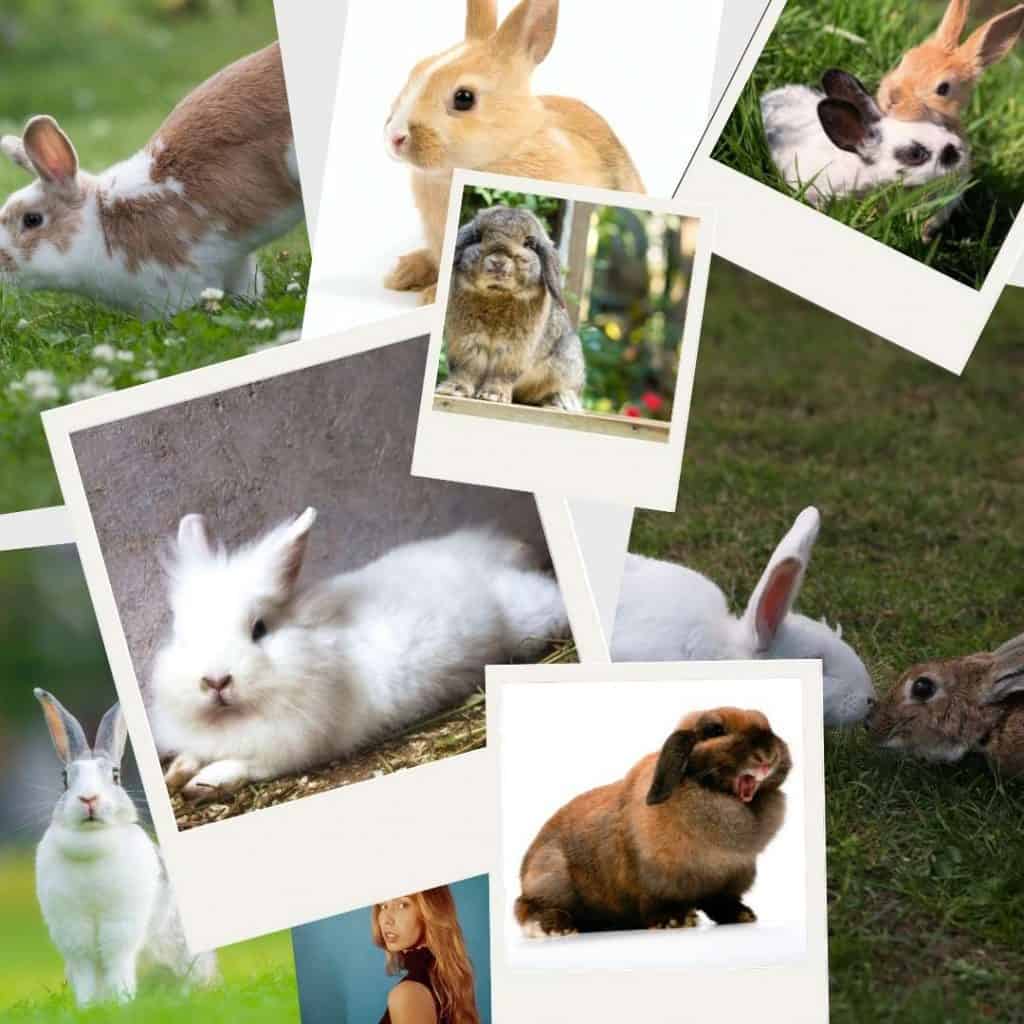
25 Common Rabbit Behaviors And Their Meaning.
While pet rabbits can’t speak, they can communicate through their actions and exhibited behaviors. Once you learn to read the body language of your bunny, it’s almost like being able to know what your rabbit is thinking. There are twenty-five common rabbit behaviors.
Some rabbit behaviors are obvious and others very subtle. In this article, ’ll try to unpack most of them so you are better at reading pet rabbit body language.
However, don’t forget that rabbit body language isn’t just movements. Rabbit behavior also consists of sounds and vocalizations. Don’t worry, we’ll also consider common rabbit vocalizations in this article.
1. Relaxed Ears
Relaxed rabbit ears are ears that are laying flat on their backs or drooping to the sides of their heads. Nonrelaxed rabbit ears are more upright and are probably moving from side to side to listen in different directions for signs of danger.
Rabbits are prey animals and as such they must always be on guard for the presence of rabbit predators. And while rabbits have pretty good eyesight for spying preditors, they mostly rely upon their hearing to avoid predators.
If your rabbit has relaxed ears, then they are a happy bunny. Here are the signs of relaxed rabbit ears:
- Ears Close Together
- Ears Slightly Lowered (not straight up)
- Ears Point Outwards (not forwards or backwards)
Relaxed ears is a rabbit behavior that indicates that your rabbit is happy and relaxed.
2. The Binky
Ah, the binky…the most beloved bunny behavior. We all love the binky so much that I’ve written a whole separate post about the amazingly cute rabbit binky behavior. Because of that, I’m not going to go into lots of details about binky’s here, I’m just going to give you the basics.
If you want the binky details, you should visit our bunny binky article which even includes videos so you can experience the joy of the binky. But for now, let’s cover the basics.
There are two types of binkying, the full binky, and the half binky. A full binky consists of a bunny jumping in the air while twisting its body. The half binky, however, is only the flicking of the ear or a fast head flick.
But, whether your bunny loves to do the full-on Binky or the half-binky, binkies are signs of a happy rabbit. The ability of a rabbit to binky is all due to their amazing skeletal systems. Bunnies have light bone structures but have very strong muscles thus allowing them to leap and twist in the air.
3. The Flop
The bunny flop isn’t the same as a human flop where someone fails in their endeavors. No, bunny flopping takes on a different meaning and there is no failure involved, just a bunny living its best life.
Bunny flops is a common rabbit behavior characterized by a sudden flop from standing to laying on their side. These flops can often happen at a near run and end with your bunny lying peacefully on their side and appearing to be asleep.
Bunny flops are also called “Bunny Lamb Chops” because some people think that a bunny resting in a flop kind of looks like a pair of lamb chops…a cut of meat.
Some owners panic the first time they see their bunnies do the flop, but flopping is not a behavior to worry about.
Bunnies only flop when they are happy and feel safe and comfortable in their environment.
The bunny flop can also be preceded by other rabbit behaviors such as binkying or zoomies. A flop that is done after such activities means that your bunny is tired but feeling happy and totally safe. They might even purr or grind their teeth softly to tell you how contented they are.
However, did you know that rabbit flopping is also a body language that rabbits use to mock other rabbits?
It’s true when rabbits don’t like the other rabbit that they’re with they usually do a flop on the side to send a message that they’re so comfortable in their space they do not care enough to fight the other rabbit. This is extremely cute and also extremely interesting. Who knew that bunnies could be so sassy and passive-aggressive just like humans?
Flopping is done by comfortable rabbits because this position leaves them very vulnerable to predators as they cannot run quickly coming from this position.
The flop is a rabbit behavior that indicates that your rabbit is happy and feels safe.
4. Soft Teeth Grinding
Did you know that rabbits can purr?
Rabbit can purr, and they do purr! And rabbit purring is usually partnered with a soft tooth grinding. This might be hard to hear because they don’t do this loudly but listen closely when you and your rabbit are in a quiet space and you’ll hear this clear sign of a happy rabbit.
Rabbits tend to softly grind their teeth when they are happy and feel completely safe. It often happens when you are petting or stroking their heads. As an added benefit, this soft teeth grinding also helps to keep a rabbit’s teeth well-trimmed.
Soft Teeth grinding is very different from loud teeth grinding.
Loud teeth grinding does not mean a more comfortable or happier rabbit, it’s a sign that you need to take your rabbit to your rabbit veterinarian and we’ll talk more about that below.
Soft teeth grind is a rabbit behavior that indicates that your rabbit is happy and feels safe.
5. The Rabbit Circle (at your feet)
Rabbits circling around each other is mating behavior but it’s a behavior that is often transferred to a bunny’s human when your bunny wants to demonstrate their affection for you and to spend time with their person.
While circling is normally a matting behavior, this behavior can still be seen in fixed rabbits (rabbits that have been spayed or neutered). Fixed rabbits who still circle your feet mean that they are showing you their affection.
This is one way for rabbits to say that they like you, it is also a way to get your attention. Check if you’re near their jar of favorite treats or maybe you’re holding their favorite toy. Rabbits running around in a circle is a sure sign that your rabbit is happy, excited and content.
A rabbit circling your feet is an indication that your rabbit is happy.
6. The Rabbit Play
This is pretty self-explanatory, after all, what rabbits would be willing to play if they are not happy or comfortable in their environment? Rabbits are prey animals and are therefore more skittish or more nervous than, say, your pet dog or cat.
If your bunny doesn’t feel safe in their environment they will tend to hide in their hutches or under sofas and beds.
Rabbits who play around comfortably are a sure sign that they are happy and content. Rabbits play like children, they run around, jump on furniture and throw their toys around. If you see your rabbit exhibiting these behaviors then your rabbit is playing and is perfectly happy in its surroundings.
7. The Bunny Grooming
Bunnies are fastidious and meticulous when it comes to grooming. They are not considered stinky animals because of this behavior. Bunny grooming is very similar to that of felines.
When a bunny grooms themself, they will first lick their paws and then uses their wet paws to clean other parts of their body. Rabbits tend to clean themselves constantly and it’s likely that you’ll catch your pet having a grooming session multiple times in a day.
Rabbits also use grooming as a sign of affection to other rabbits. A very well-bonded pair of rabbits will groom each other to show their affection. Rabbits will ask their companion rabbits to groom them by putting their head on the ground and nudging the chins of their companions.
This behavior also translates to rabbit-human behavior. You may find that your rabbit nudges you or licks you.
When your rabbit licks you they are showing their affection by “grooming” you. Bunny licks are adorable and totally safe for you and your bunny as long as you don’t have anything toxic on your skin. Bunny licks are sure to make you smile because they tickle!
A soft nudge also means that your rabbit is trying to get your attention. Try to indulge in this behavior and give your rabbit gentle scratches on the head. You may also listen closely to hear if your rabbit is purring or softly grinding its teeth.
A rabbit grooming itself or others is an indication that your rabbit is happy.
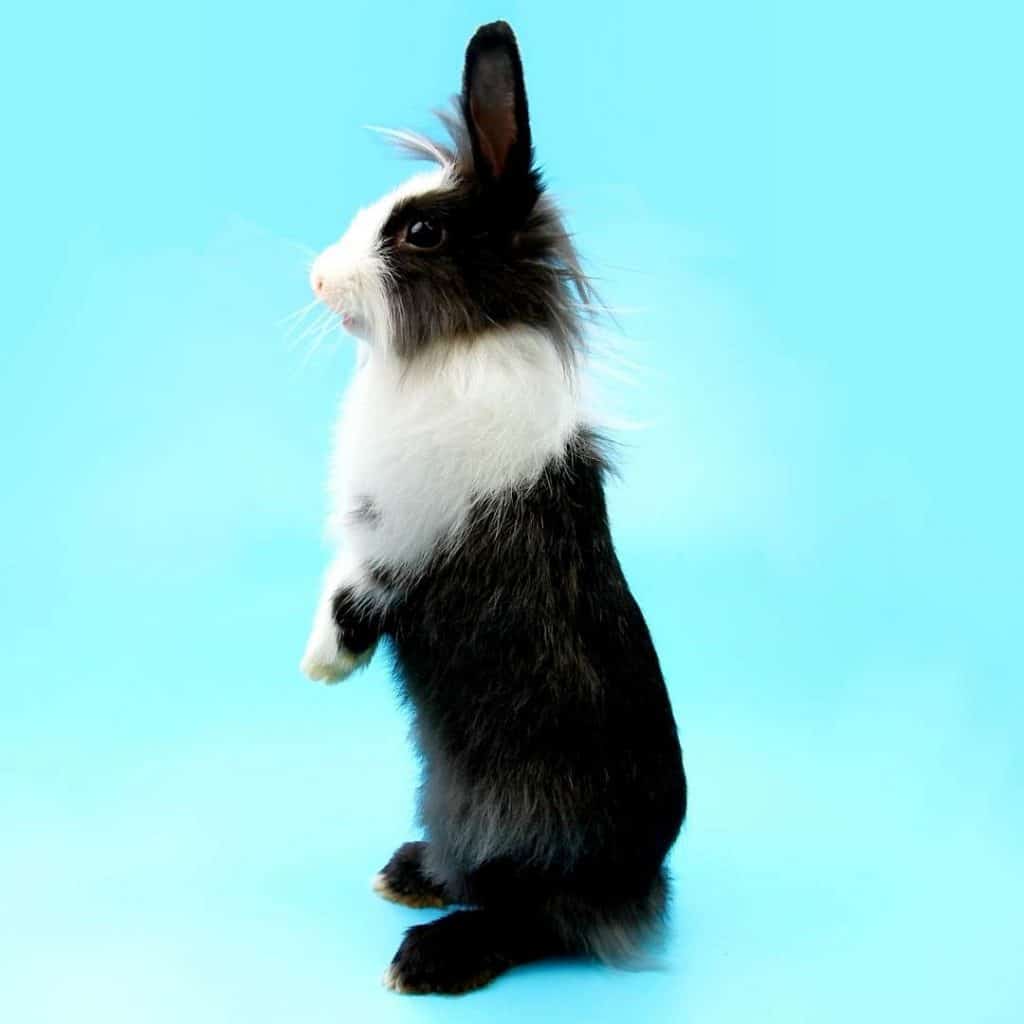
8. Bunny Eating Cecotropes
There are two types of fecal matter that bunnies produce: regular fecal pellets and cecotropes.
A rabbit’s normal fecal pellets are round, regular-shaped pellets that rabbits produce each day and in large quantities. It is a general belief that rabbits can poop up to 200 pellets in a day!
However, these pellets are quite hard and are made up primarily of undigested fiber. If you try to apply pressure to one pellet it should crumble instead of being squishy. Inside of the pellet is just fiber or hay. These pellets really don’t even stink like poop.
The second type of rabbit fecal matter is called Cecotropes. Cecotropes are round, squishy fecal matter that is bunched together. It usually looks like blackberries. They are soft and, unlike fecal pellets that crumble, cecotropes are squishy. It is also a whole lot stinkier than normal rabbit poop. However, rabbits will eat cecotropes.
The reason rabbits eat this special kind of poop is simple: the health of any rabbit is very closely related to their gut health. For rabbits to extract their needed energy, they need to be constantly eating and their digestive tracts need to move fast.
Since not all nutrients are absorbed during the first pass of the food in their stomachs, that food (nutrients) pass through the rabbit as cecotropes and so that the rabbit can eat them a second time to get their full nutrients.
Cecotropes are perfectly normal, but an abundance of cecotropes might also mean that your rabbit is eating too many treats and needs to have more fiber in its diet.
A rabbit eating cecotropes is a sign that your rabbit is happy and healthy.
9. Butt Twitching
Butt twitching is a super cute rabbit behavior. You might notice that when you give your rabbit their favorite treats they do a little butt twitch, sometimes to the extent that they seem like they’re vibrating. Butt twitches are a happy bunny dance.
It’s common to see bunnies do a butt twitch when they’re eating their cecotropes (yes, a little gross), however, try feeding your bunny a banana and you’ll probably see the same behavior.
Bananas are like the catnip of the rabbit kingdom. Bunnies are obsessed with this fruit! If it seems that your bunny is enjoying its treats but is not twitching its bum, that’s okay too. Each rabbit to its own, some rabbits like to butt twitch, some just like to chill or show their happiness and excitement in other ways.
Butt twitching is a rabbit behavior that means that your rabbit is happy.
10. Bunny Zoomies
You might have seen the “zoomies” behavior with dogs. Just like dogs, rabbits also do zoomies in which they run around at a fast speed.
Rabbit zoomies are also called the “Rabbit 500” because they look like they’re going at a high speed of 500 mph.
Rabbit zoomies are done not because they’re scared. This is the behavior of an excited and happy rabbit. They might also be doing this to release some pent-up energy.
Zooming is a rabbit behavior that indicates that your rabbit is happy.
11. Loafing
A bunny is in a loaf position when they tuck all their feet under themselves, slick back their ears, and squint their eyes. If your bunny is extra fluffy then they really would look round like a new loaf of bread.
You might think that your rabbit is judging you with their eyes squinted but worry not, rabbits are not judge-y, loafing is a sign of an extremely content rabbit.
Only rabbits who are 100% sure of their surroundings will be in this position because tucking their feet underneath them will make it harder for them to run when a predator comes.
Loafing is a rabbit behavior that means that your bunny is happy and feels safe.
12. Chinning
Chinning is a territorial rabbit behavior.
Chinning is when your rabbit rubs his chin over surfaces. It is a behavior used by rabbits to mark their territories by rubbing their chins on surfaces to transfer their odor to those objects.
Rabbits have scent glands in their chins the other scent gland that they have is actually in their anus. But thankfully, they don’t rub their butts on the surface of things and would rather just rub their chins instead. This isn’t a harmful behavior as it won’t stink up your home and your not-so-sensitive human nose won’t be able to pick up the scent.
However, rabbits can also use chinning to mark things if they want to investigate them later. They can also leave their scent on things so that they can be reminded that they have been in that place and can use it to navigate their way around the house especially when they are in a new habitat.
Chinning is a rabbit behavior that means that a rabbit is nervous or at least tense in its environment.
13. Urine Spraying
Spraying urine is another behavior that is due to your bunny’s territorial nature. Rabbits will spray urine in both vertical and horizontal places to mark their territories.
Unlike chinning, this is quite a nuisance for you as a pet owner because rabbit urine smells and you don’t want to always keep cleaning your house for rabbit sprays.
Spaying or neutering bunnies will drastically help curb this behavior. Ensure that your bunny has a litter box and is litter trained to keep them going to the bathroom in one place only.
Urine spraying is a rabbit behavior that indicates that your rabbit is mad, upset, or looking to mate.
14. Rabbit Scattering Droppings
Rabbit scattering their pellets everywhere is more than just a sign of bad litter box habits. Your rabbit can also be intentionally scattering their droppings everywhere because they are trying to mark their territory.
Bunny pellets are not necessarily stinky but the amount of pellets that they produce every day is a large amount and hence, cleaning up after them will always be a chore.
Spaying and neutering will also help curb the behavior as well as ensuring that they are litter trained.
If you find that your bunny still keeps on doing this bad behavior even after getting fixed then don’t give up and just stick to the training. Rabbits are intelligent creatures and they will eventually get the hang of using the litter box.
Scattering Droppings is a rabbit behavior that can mean that your rabbit is upset, though some rabbits are just messy.
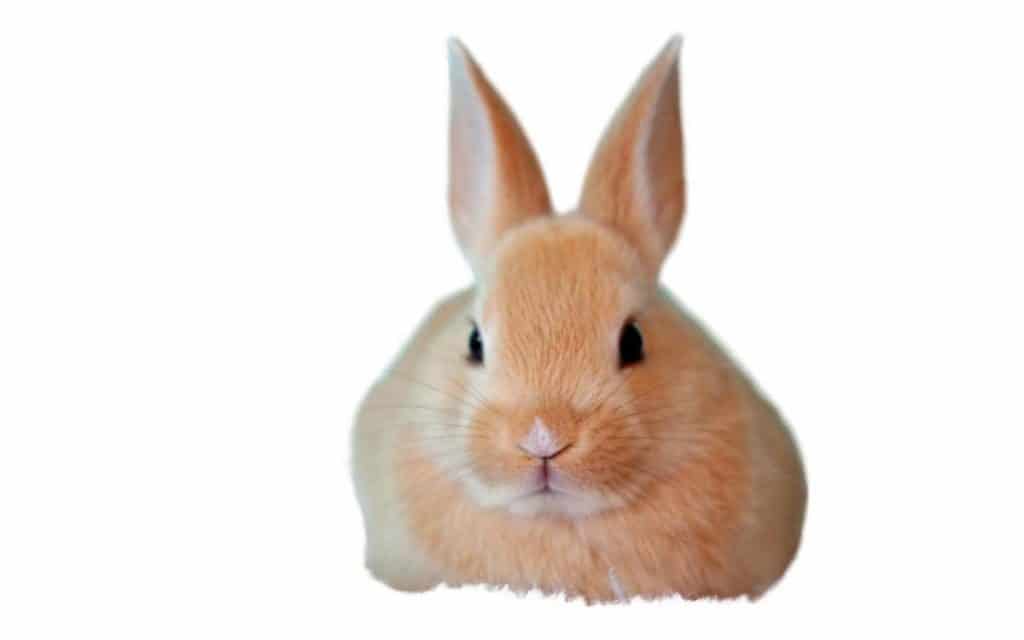
15. Fur Pulling
Rabbit fur pulling can be caused by pregnancy, parasites like fleas, skin conditions, stress, or nervousness, You should eliminate the possibility of the first three causes before beginning to work on reducing your rabbit’s stress and nervousness.
This behavior is usually exhibited by female rabbits and is part of a nesting instinct, however, sometimes pulling out their own fur is a nervous behavior.
If your bunny is exhibiting this behavior, the first thing to do is to eliminate the possibility that they might be pregnant. I’m not going to go into great detail here, but I will give you the basics in seeing if your rabbit might be pregnant.
First, is your rabbit a boy or a girl? Only girl rabbits get pregnant.
If you have a girl bunny, then has that girl rabbit been spayed? A spayed rabbit doesn’t get pregnant.
Finally, has your unspayed female rabbit had any contact with a male rabbit? I want to stress “ANY”. Rabbit mating happens very fast and just because you didn’t see it happen doesn’t mean it didn’t happen.
So, if after going through those questions you think there is any chance that your fur pulling rabbit might actually be pregnant and making a nest, then you should go read our article about pregnant rabbits where you can learn how to find out if your rabbit is actually getting ready to have a litter of bunnies.
16. Boxing
Boxing is a defensive stance that is used by rabbits to tell an approaching stranger to back off. A rabbit is said to be boxing when they shift their weight to their hind legs and use its front legs to sort of swat you away. This behavior is usually observed in rabbits who are territorial or who are trying to protect something.
Boxing is also always preceded by an audible grunt.
Give your bunny some space if they do ever exhibit this behavior. If your rabbit isn’t spayed or neutered then having them sexually fixed can help solve the behavior. If you push a rabbit while they’re being defensive then they might bite you and that is something you want to avoid as much as possible.
Boxing is a rabbit behavior that indicates that your bunny is nervous, scared, or angry.
17. Periscoping
Periscoping is when your rabbit stands on its hind legs and looks around. This is a very curious stance and just means that the bunny would like to widen its visual horizon to try and scope the place. Maybe they may even smell that the treat jar is nearby and would like to check if they can reach it.
Periscoping is a rabbit behavior that indicates that your bunny is nervous and on guard.
18. Growling Or Grunting
Yes, rabbits do growl. Surprising huh?
A rabbit growl sounds more like a grunt or blowing air than it sounds like a dog’s growl. However, when it rabbit growls it’s giving the same warning that a growling dog is giving. A growling rabbit is warning you to give them space…or else.
This might take you by surprise because you might think that bunnies are such docile animals. However, it is important to remember that rabbits also have the instinct to protect themselves, therefore, they will retaliate if they sense that they are in danger and fleeing isn’t an option.
Since it’s hard to describe what a rabbit growl sounds like, I found a good video so you can know what to look for.
Growling is a rabbit behavior that indicates that your bunny is scared or angry.
19. Lunging
Lunging is when your rabbit moves towards you aggressively without really trying to make contact or kick you. Lunging can be a run or a jump. It is a warning sign for the person or other animal to stay away and is almost always accompanied by growling.
It is also recommended to give rabbits some space whenever they do lunge and allow them to explore their surroundings for a while until they feel comfortable. However, if you notice that your rabbit is in pain and exhibiting signs of sickness then a scheduled visit to your rabbit veterinarian is a must.
Lunging is a rabbit behavior that indicates that your rabbit is scared or angry.
20. Mounting
Mounting is when your rabbit climbs on top of another rabbit, animal, stuffed animal, or even your foot with their front feet while their back feet remain on the ground. Then they thrust their hips back and forth as if mating.
Mounting or “humping” is a trait that is commonly seen in unneutered males however, it can also be seen in fixed rabbits as well.
This behavior is very common in the rabbit kingdom and can indicate two things.
The first is that the rabbit wants to reproduce. There is probably a whole load of hormones raging inside your bunny to keep them indulging themselves with this behavior,
Mounting is also a behavior that exhibits dominance. Rabbits may mount each other to show that they are more dominant than another.
It is important for you to observe how other rabbits or other animals (yes, rabbits will mount anything) respond to this behavior. A mounted rabbit may not be willing to concede to the dominant rabbit and might retaliate. In this case, it is better to separate the two bunnies to avoid fights and unnecessary injuries
Mounting is a rabbit behavior that indicates that your rabbit wants to mate or is unhappy with other animals they are living with.
21. Thumping or Stomping
I often call bunnies “ thumpers” on this page because it’s cute and they do thump.
A thumping rabbit will arch their back and use its hind legs to make a loud thumping sound as they stomp on the ground. The thumping sound is a warning sound that is used by rabbits to warn other rabbits that there is something scary nearby.
However, some rabbits just thump or stomp for purely diva-ish reasons. They might thump to express their annoyance or because they want some cuddle time and they couldn’t quite get your attention.
Thumping is a rabbit behavior that indicates that your rabbit is scared, annoyed, or just wants attention.
22. Shrill Scream
Rabbits can scream too.
A rabbit scream is a very loud and high-pitched squeal that will make the hair on your arms stand up. Rabbits scream when they are very scared or are in pain.
This is a very unpleasant sound to hear especially to bunny lovers who only want the best for their pet bunnies.
If you suddenly hear a scream from your rabbit then it might mean that your rabbit is in deep pain. It is also known that some rabbits scream just before dying. Rabbits can also sometimes scream when they are having a seizure. The important thing to note here is that, unlike thumping, screaming is always a sign of a bunny in distress and should not be ignored.
Screaming is a rabbit behavior that indicates extreme fear or pain.
23. The Flick Off
The flick-off is characterized by a rabbit clicking its hind legs together or on the ground before hopping away. Bunnies can give a flick off when they are upset or annoyed at you.
A Flick off might be followed by a cold shoulder where the bunny will ignore you even when called. Try giving your rabbit a treat as an apology gift and they’re always sure to forgive you.
24. The Hunched Bunny
A hunched bunny looks very similar to a loafing rabbit, and the only way to tell the difference is by watching your rabbit’s ears. Loafing bunnies have their ears plastered back in a relaxed position while a hunched rabbit will look very tense and will have ears either raised or dropping to the side of their head. They might also be grinding their teeth firmly.
Hunched rabbits are often sick rabbits and need to be taken care of immediately.
Rabbits who are also hunched will refuse to move or eat, even their favorite treats. Know that rabbits will try to conceal if they’re unwell so you have to know the nuances of your rabbit’s behaviors. Anything out of the ordinary should merit investigation.
Hunching is a rabbit behavior that usually indicates that a rabbit is sick or uncomfortable.
25. Loud Teeth Grinding
Loud teeth grinding is when your rabbit grinds their teeth together so hard that it’s an easily heard sound. In many cases, you will even see their jaws working from side to side as they grind their teeth.
Sick rabbits will also loudly grind their teeth. This means that your rabbit is in extreme pain. Rabbits will only grind their teeth loudly to self-soothe.
It is important then to take note of any changes to your rabbits’ behaviors such as low appetite, irregular bowel movements, or lethargy. If your rabbit is in pain, you need to immediately schedule a vet visit to know what is going on.
Loud teeth grinding is a rabbit behavior that indicates that your rabbit is sick or uncomfortable.
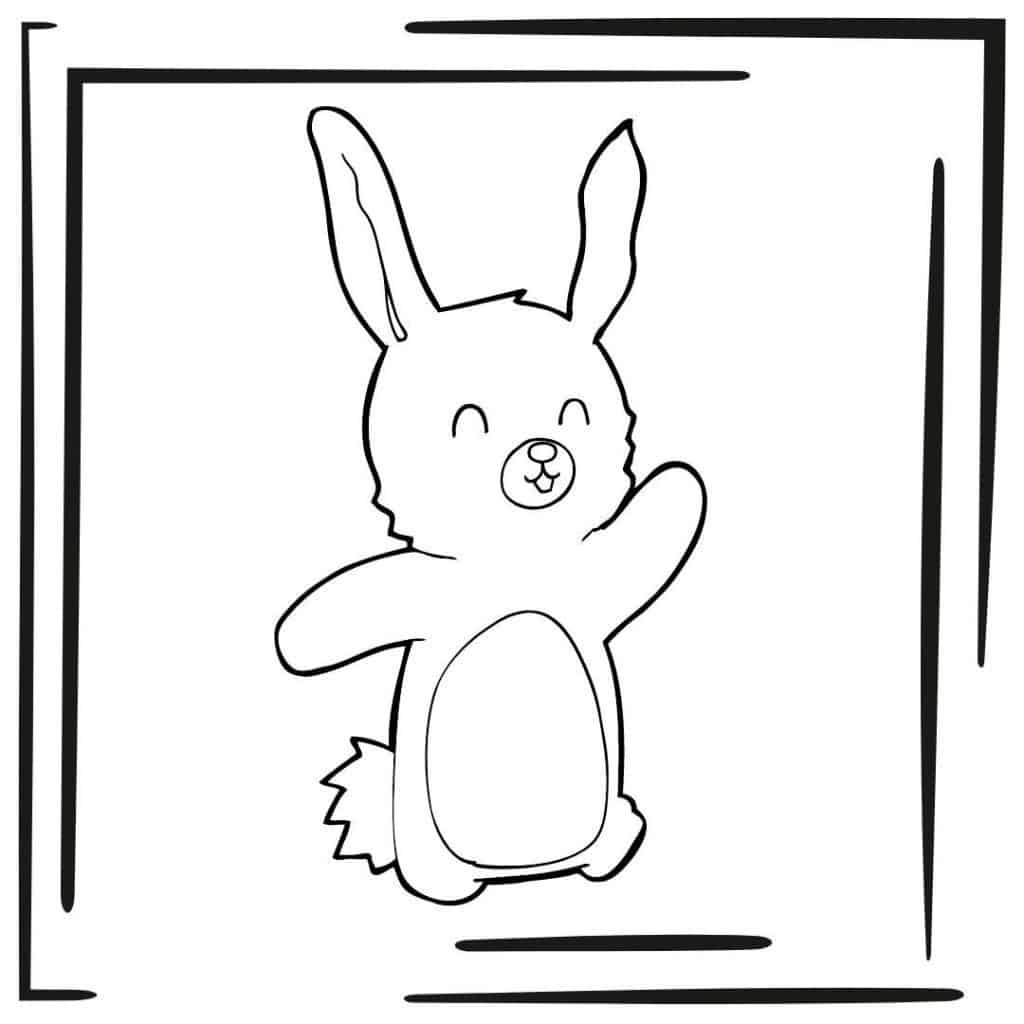
11 Signs That Your Rabbit Is Happy
If you learn to identify the following rabbit behaviors, you’ll be able to know when your pet bunny is happy.
- Relaxed Ears
- The Binky
- The Flop
- Soft Teeth Grinding
- Circling Your Feet
- Playing
- Grooming
- Eating Cecotropes
- Butt Twitching
- Zooming
- Loafing
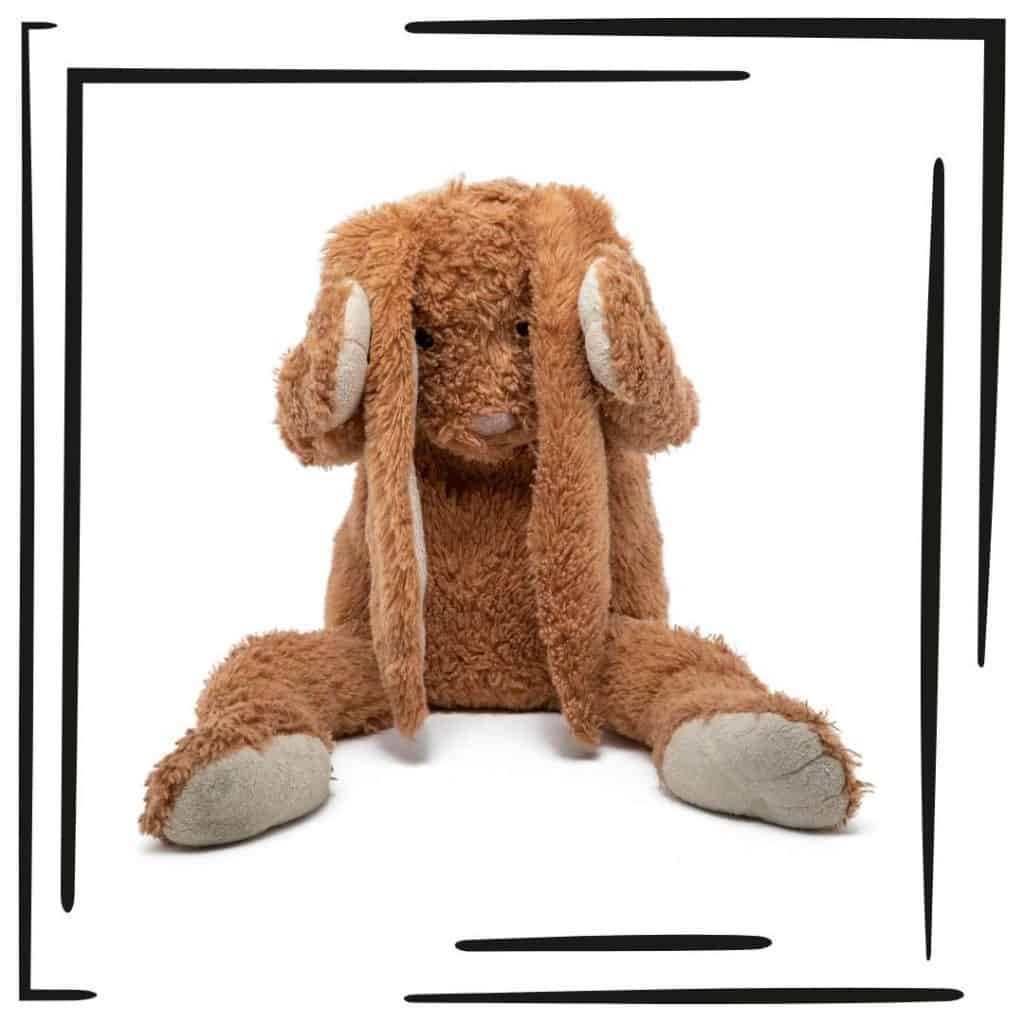
6 Signs That Your Rabbit Is Nervous Or Scared
There are many rabbit behaviors that your rabbit can exhibit when they are nervous or on high alert, and considering that rabbits are natural prey animals, being nervous and alert is a pretty common state.
- Chinning
- Boxing
- Parascoping
- Growling
- Lunging
- Thumping
- Fur Pulling
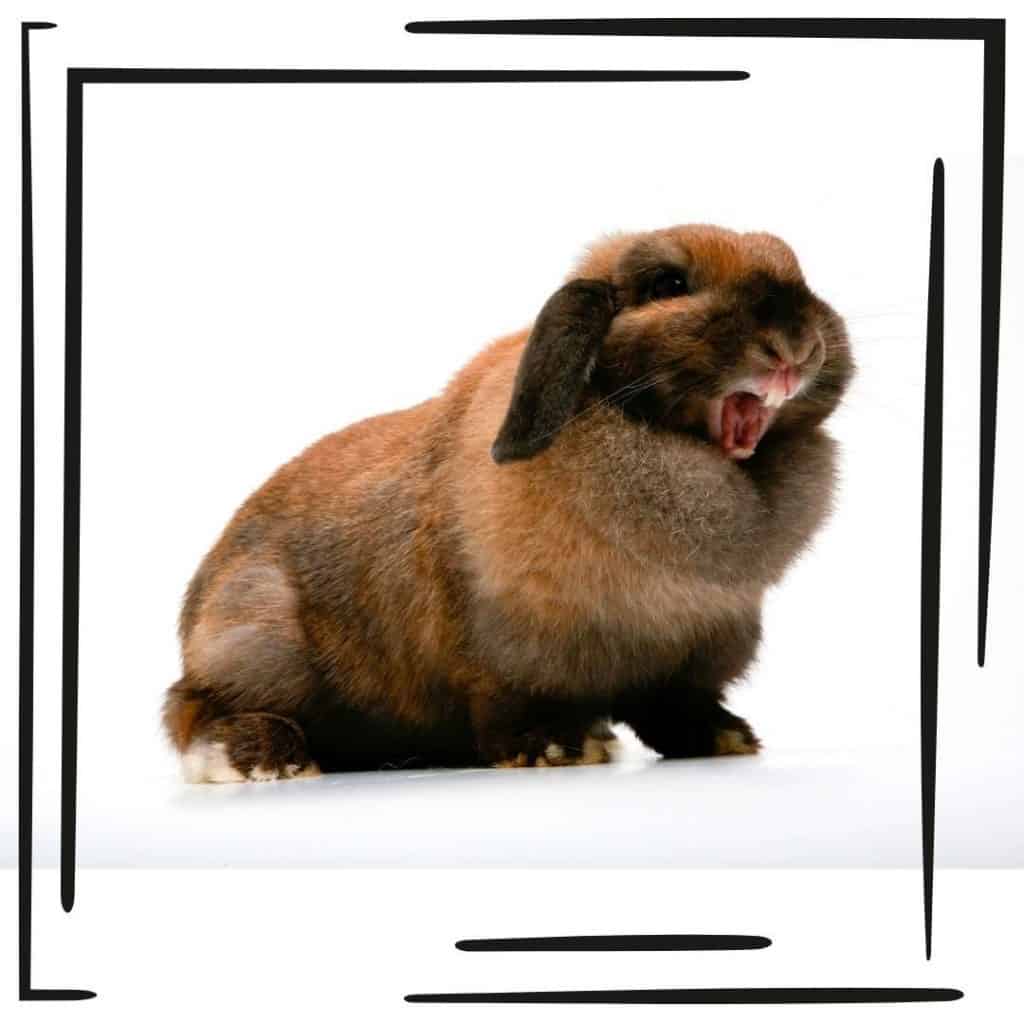
5 Signs That Your Rabbit Is Mad Or Angry
Just like us, sometimes rabbits get angry and when you learn to read their body language you’ll know when they aren’t happy.
- Growling
- Lunging
- Mounting
- Thumping
- The Flick Off
Though this article was long, I hope it was packed full of information that makes you feel better armed to read your bunny’s mind by learning to read his body language.
Does your rabbit have any other behaviors that are cute or rare? Share them in the comments below and be sure to jump over to Facebook and like our page and join our group of rabbit friends.
~Stacey
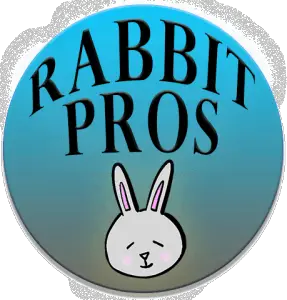
My bunny changes her behaviour with the coming full moon. She gets very excitable, runs at me then licks my ankle followed by a soft nip. Is this normal behaviour? She calms down once the moon has been and gone and is less needy.
Thank you
Beverley